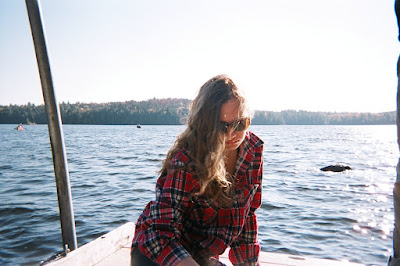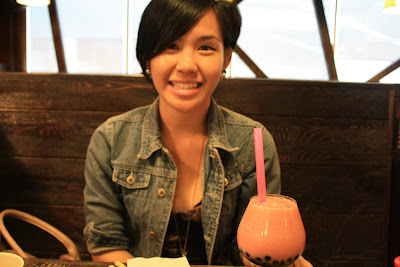
Sunday, October 30, 2011
Saturday, October 29, 2011
Tuesday, October 25, 2011
Monday, October 24, 2011
I Need You!
My lovely, wonderful friend Angie bought me a ticket to see Mayer Hawthorne for my birthday. I get to see him live in like two weeks! YES! I might just ask him to marry me?!
Wednesday, October 19, 2011
Public vs Private Space Project
I've always had a little bit of a thing for sheep. Especially this one who smiled when I took his (?) photo. I named him Albert.
Sunday, October 16, 2011
A Snapshot of Prejudice.
The clear water of Christian Island is enticing, the 15 children somersaulting off the rocks is a foreign game; I wrap my hand around the body of the camera and lift it to my eye but stop before clicking the shutter and capturing my island paradise.
Paradise is not a summer vacation to the 700 Chippewa people of the Beausoleil First Nation, who call the small native reserve their home. Organized as if it were a small city, the ferry service, hospital, fire department, forestry group, housing association, public works, elementary school and social services are all run by residents of the island.
This self-sufficient reserve was enthralling to me as a documentary photographer because it represented community, teamwork and was pleasing aesthetically. Near the end of my trip I set out to explore the community with my camera and experienced the tensions of photographing my surroundings, especially the residents, as a non-aboriginal.
I have been around and participated in Native spirituality my whole life and call a residential school survivor my “uncle”. My skin colour however told a different story on Christian Island. I was an intruder of land that does not belong to me; reserves, defined in the Indian Act are “held by Her Majesty for the use and benefit of the respective bands for which they were set apart”.
With a camera slung around my neck and no way of displaying my personal connection to the aboriginal culture, my skin colour separated me from the community and made me feel very disrespectful. The General Store on the reserve hosts a small retro 60’s snack bar, the only “restaurant” on Christian Island. This setting was interesting to me as a photographer because it was a snapshot of time gone by. Approaching the server behind the counter to ask he be included in the photo, I hesitated. Was he going to think I was a “white girl” tourist trying to capture of an “Indian?” I never got that shot.
In the essay “Ideology of the Visual”, Glynn Davis believes that “dominant ideas” which are expressed in “diverse institutions” (such as newspapers and radio) are believed by viewers to be “true…because they are established by the media”.
Edward Curtis’ early 1900s photographic project The North American Indian is an example of how a dominant idea of a large group of people can be transmitted through the institution of photography. Curtis describes his aim of photographing aboriginals as a chance to “show what actually exists or has recently existed”. Through his images of aboriginals in traditional headdresses and on horses equipped with bow and arrows, Curdis captured the one stereotype of aboriginals as “untutored savage[s]” that still exists today.
My summer vacation on Christian Island awoke my own understanding that prejudice goes both ways. The history of unfair treatment against Aboriginals was only acknowledged by the Canadian Government 3 years ago through Stephen Harpers apology for residential schools. Clément Charier, President of the Métis National Council described the apology as “a day for all Canadians to move forward”. Have we made any progress in 3 years? That is something I cannot answer. What I do know is that tensions still exist; the feelings I experienced on Christian Island this past summer will not go away until aboriginals and non-aboriginals have a true understanding and respect for each other. This is only the beginning.
Paradise is not a summer vacation to the 700 Chippewa people of the Beausoleil First Nation, who call the small native reserve their home. Organized as if it were a small city, the ferry service, hospital, fire department, forestry group, housing association, public works, elementary school and social services are all run by residents of the island.
This self-sufficient reserve was enthralling to me as a documentary photographer because it represented community, teamwork and was pleasing aesthetically. Near the end of my trip I set out to explore the community with my camera and experienced the tensions of photographing my surroundings, especially the residents, as a non-aboriginal.
I have been around and participated in Native spirituality my whole life and call a residential school survivor my “uncle”. My skin colour however told a different story on Christian Island. I was an intruder of land that does not belong to me; reserves, defined in the Indian Act are “held by Her Majesty for the use and benefit of the respective bands for which they were set apart”.
With a camera slung around my neck and no way of displaying my personal connection to the aboriginal culture, my skin colour separated me from the community and made me feel very disrespectful. The General Store on the reserve hosts a small retro 60’s snack bar, the only “restaurant” on Christian Island. This setting was interesting to me as a photographer because it was a snapshot of time gone by. Approaching the server behind the counter to ask he be included in the photo, I hesitated. Was he going to think I was a “white girl” tourist trying to capture of an “Indian?” I never got that shot.
In the essay “Ideology of the Visual”, Glynn Davis believes that “dominant ideas” which are expressed in “diverse institutions” (such as newspapers and radio) are believed by viewers to be “true…because they are established by the media”.
Edward Curtis’ early 1900s photographic project The North American Indian is an example of how a dominant idea of a large group of people can be transmitted through the institution of photography. Curtis describes his aim of photographing aboriginals as a chance to “show what actually exists or has recently existed”. Through his images of aboriginals in traditional headdresses and on horses equipped with bow and arrows, Curdis captured the one stereotype of aboriginals as “untutored savage[s]” that still exists today.
Saturday, October 15, 2011
Monday, October 10, 2011
Wednesday, October 5, 2011
A New Photo!
My beautiful and talented friend Nazia drew me my new display photo.
Visit her here: http://jazzypolkadots124.blogspot.com/
Subscribe to:
Posts (Atom)











































